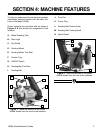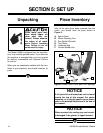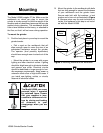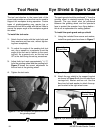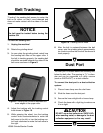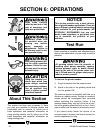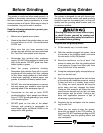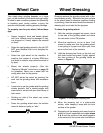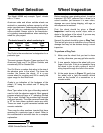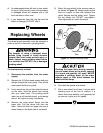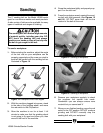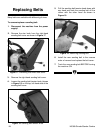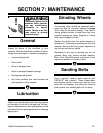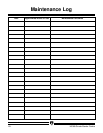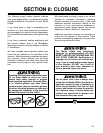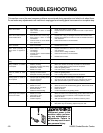
H3368 Grinder/Sander Combo -15-
Wheel Inspection
Before mounting a new grinding wheel, it must be
inspected. DO NOT assume that a wheel is in
sound condition just because it is new—often,
damage can occur during shipping, with age, or
with exposure to moisture.
First, the wheel should be given a Visual
Inspection. Look for any cracks, chips, nicks, or
dents in the surface of the wheel. If you see any
of these, DO NOT use the wheel.
Second, the wheel should be given a Ring Test.
This test will give you an indication of any internal
damage that may not be obvious during a visual
inspection.
To perform a Ring Test:
1. Make sure the wheel that you test is clean
and dry; otherwise, you may get false results.
2. If size permits, balance the wheel with your
finger in the hole. If this is not possible, hang
the wheel in the air with a piece of cord or
string looped through the hole in the center.
3. At the spots shown in Figure 12, gently tap
the wheel with a light non-metallic device
such as the handle of a screwdriver or a
wooden mallet.
Figure 12. Ring test tapping locations.
The Model H3368 only accepts Type-1 wheels
with a
1
⁄2" bore.
Aluminum oxide and silicon carbide wheels are
marked in a somewhat uniform manner by all the
major manufacturers. Understanding these mark-
ings will help you understand the capabilities of
various wheels. Always refer to the manufactur-
er’s grinding recommendations when selecting a
wheel for your project.
The basic format for wheel numbering is:
Prefix Abrasive Grit Grade Bond
Type Size Type
1A60LV
The Prefix is the manufacturer’s designation for a
particular type.
The most common Abrasive Types used are A for
Aluminum Oxide and C for Silicon Carbide, and
occasionally SG for Seeded Gel.
The Grit Size is a number that refers to the size of
the abrasive grain in the wheel. The lower the
number, the coarser the wheel. 10 is a very
coarse wheel for roughing and 220 is usually the
upper range for fine finish work.
Grade is an indication of the hardness of the
wheel—“A” being the softest and “Z” being the
hardest.
Bond Type refers to the type of bonding material
used to hold the abrasive material. Most general
purpose wheels will have a “V” indicating Vitrified
Clay is used. Vitrified Clay provides high strength
and good porosity. The other common bond type
is “B” for resin where synthetic resins are used.
These are used to grind cemented carbide and
ceramic materials.
There may be other numbers inserted that have
meaning for a particular type of wheel. Refer to
the manufacturer’s technical data for a complete
explanation.
Wheel Selection



